Research Proposal: Organizational Commitment and Employee Engagement
VerifiedAdded on 2023/01/18
|14
|2692
|26
Report
AI Summary
This research proposal delves into strategies for fostering organizational commitment and employee engagement, crucial for reducing attrition and boosting productivity. It begins with an introduction that highlights the importance of commitment and engagement for organizational success, followed by a background discussing the need to adapt to the needs of the present generation workforce. The problem statement identifies the ineffectiveness of current methods. The proposal aims to analyze these ineffective methods, understand the needs of the current workforce, and propose alternative strategies. The literature review explores concepts like organizational commitment, job satisfaction, role clarity, and empowerment. The methodology outlines data collection methods, analysis techniques, sample size, and ethical considerations. The expected outcome is that organizations will adopt strategies that enhance employee commitment, leading to improved productivity and job satisfaction. The research emphasizes the importance of work-life balance and flexible work arrangements for the present generation workforce.
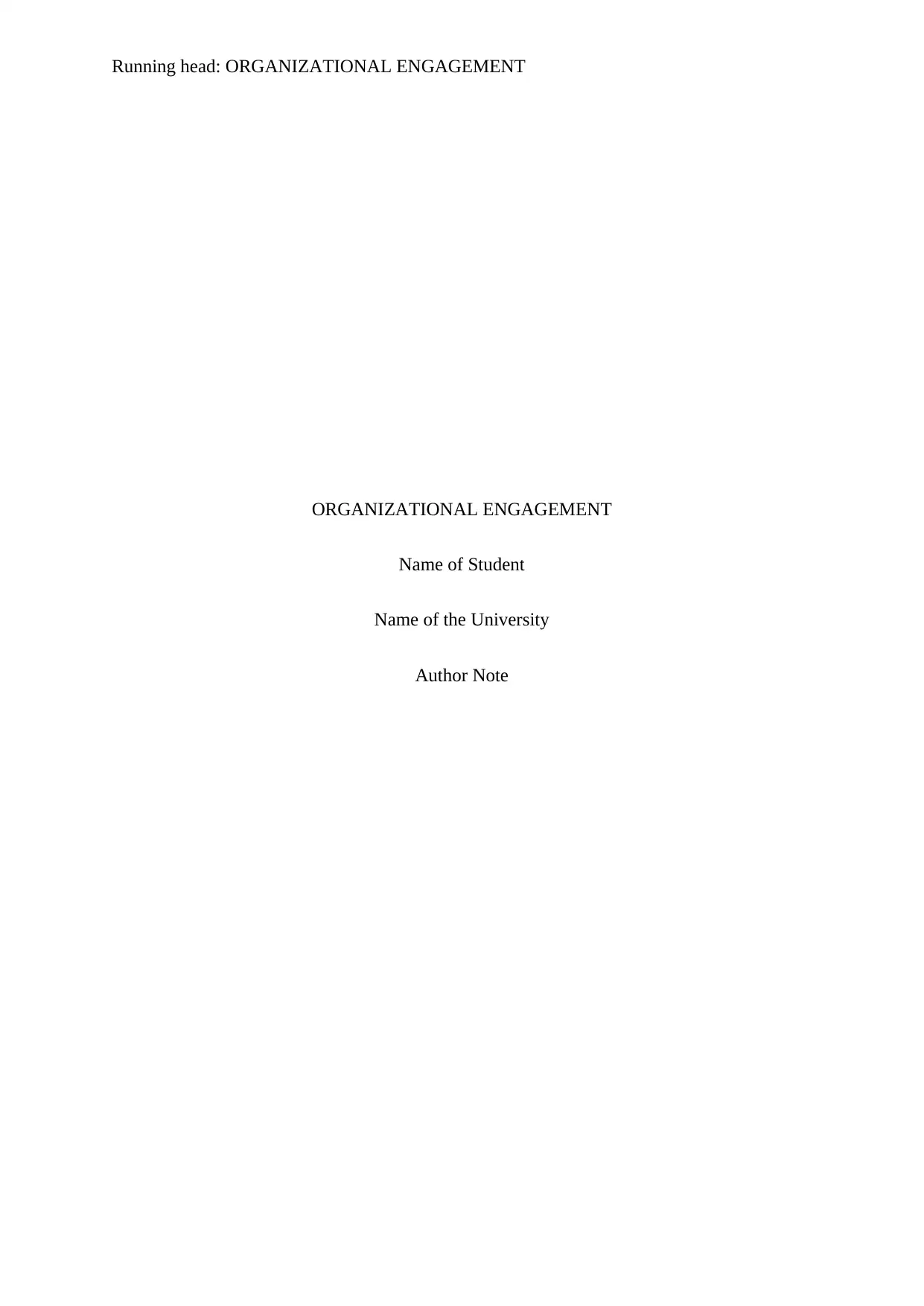
Running head: ORGANIZATIONAL ENGAGEMENT
ORGANIZATIONAL ENGAGEMENT
Name of Student
Name of the University
Author Note
ORGANIZATIONAL ENGAGEMENT
Name of Student
Name of the University
Author Note
Paraphrase This Document
Need a fresh take? Get an instant paraphrase of this document with our AI Paraphraser
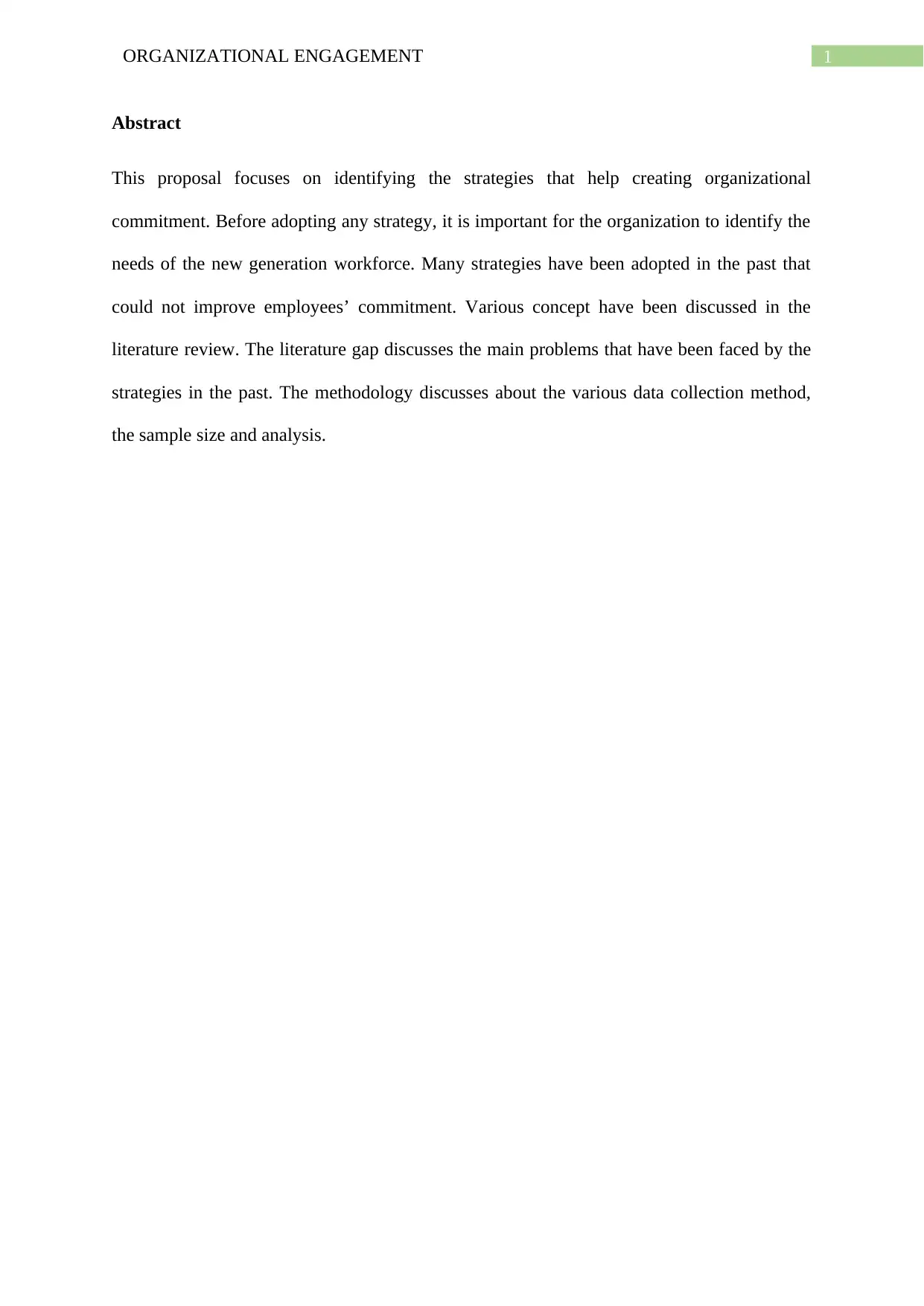
1ORGANIZATIONAL ENGAGEMENT
Abstract
This proposal focuses on identifying the strategies that help creating organizational
commitment. Before adopting any strategy, it is important for the organization to identify the
needs of the new generation workforce. Many strategies have been adopted in the past that
could not improve employees’ commitment. Various concept have been discussed in the
literature review. The literature gap discusses the main problems that have been faced by the
strategies in the past. The methodology discusses about the various data collection method,
the sample size and analysis.
Abstract
This proposal focuses on identifying the strategies that help creating organizational
commitment. Before adopting any strategy, it is important for the organization to identify the
needs of the new generation workforce. Many strategies have been adopted in the past that
could not improve employees’ commitment. Various concept have been discussed in the
literature review. The literature gap discusses the main problems that have been faced by the
strategies in the past. The methodology discusses about the various data collection method,
the sample size and analysis.
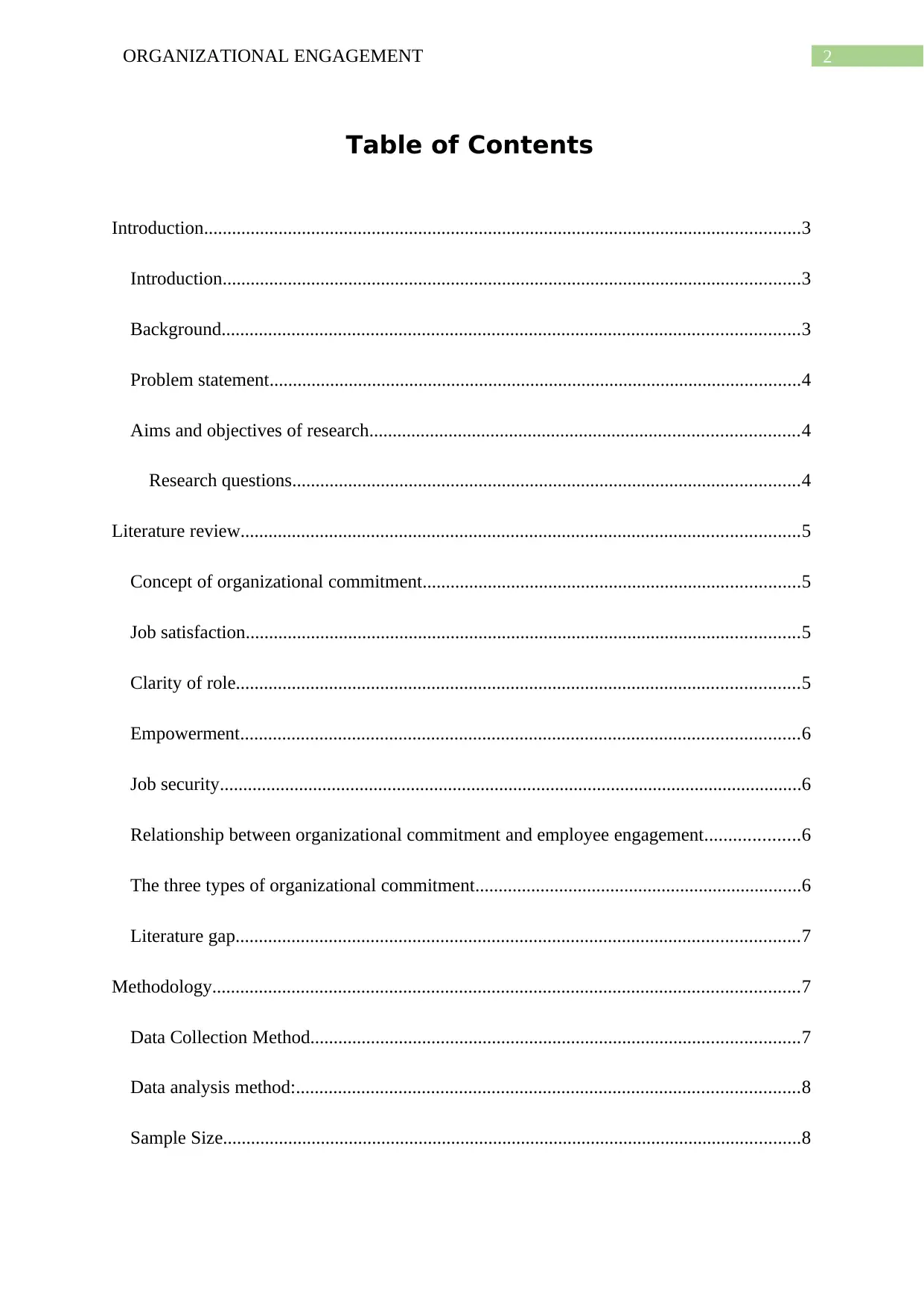
2ORGANIZATIONAL ENGAGEMENT
Table of Contents
Introduction................................................................................................................................3
Introduction............................................................................................................................3
Background............................................................................................................................3
Problem statement..................................................................................................................4
Aims and objectives of research............................................................................................4
Research questions.............................................................................................................4
Literature review........................................................................................................................5
Concept of organizational commitment.................................................................................5
Job satisfaction.......................................................................................................................5
Clarity of role.........................................................................................................................5
Empowerment........................................................................................................................6
Job security.............................................................................................................................6
Relationship between organizational commitment and employee engagement....................6
The three types of organizational commitment......................................................................6
Literature gap.........................................................................................................................7
Methodology..............................................................................................................................7
Data Collection Method.........................................................................................................7
Data analysis method:............................................................................................................8
Sample Size............................................................................................................................8
Table of Contents
Introduction................................................................................................................................3
Introduction............................................................................................................................3
Background............................................................................................................................3
Problem statement..................................................................................................................4
Aims and objectives of research............................................................................................4
Research questions.............................................................................................................4
Literature review........................................................................................................................5
Concept of organizational commitment.................................................................................5
Job satisfaction.......................................................................................................................5
Clarity of role.........................................................................................................................5
Empowerment........................................................................................................................6
Job security.............................................................................................................................6
Relationship between organizational commitment and employee engagement....................6
The three types of organizational commitment......................................................................6
Literature gap.........................................................................................................................7
Methodology..............................................................................................................................7
Data Collection Method.........................................................................................................7
Data analysis method:............................................................................................................8
Sample Size............................................................................................................................8
⊘ This is a preview!⊘
Do you want full access?
Subscribe today to unlock all pages.

Trusted by 1+ million students worldwide

3ORGANIZATIONAL ENGAGEMENT
Ethical Issues..........................................................................................................................8
Research Limitations..............................................................................................................9
Gantt chart..............................................................................................................................9
Expected Outcome...................................................................................................................10
References................................................................................................................................11
Ethical Issues..........................................................................................................................8
Research Limitations..............................................................................................................9
Gantt chart..............................................................................................................................9
Expected Outcome...................................................................................................................10
References................................................................................................................................11
Paraphrase This Document
Need a fresh take? Get an instant paraphrase of this document with our AI Paraphraser
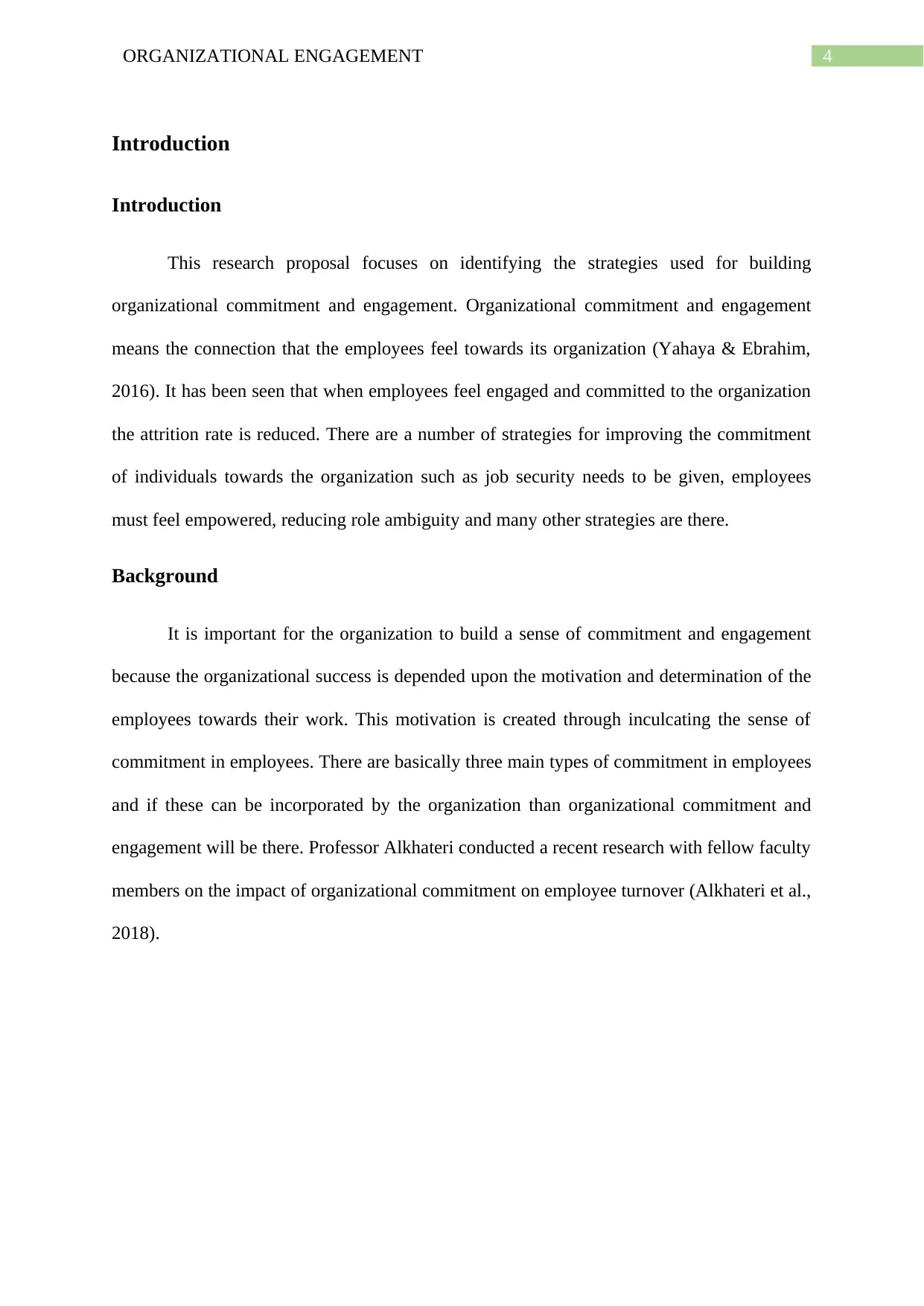
4ORGANIZATIONAL ENGAGEMENT
Introduction
Introduction
This research proposal focuses on identifying the strategies used for building
organizational commitment and engagement. Organizational commitment and engagement
means the connection that the employees feel towards its organization (Yahaya & Ebrahim,
2016). It has been seen that when employees feel engaged and committed to the organization
the attrition rate is reduced. There are a number of strategies for improving the commitment
of individuals towards the organization such as job security needs to be given, employees
must feel empowered, reducing role ambiguity and many other strategies are there.
Background
It is important for the organization to build a sense of commitment and engagement
because the organizational success is depended upon the motivation and determination of the
employees towards their work. This motivation is created through inculcating the sense of
commitment in employees. There are basically three main types of commitment in employees
and if these can be incorporated by the organization than organizational commitment and
engagement will be there. Professor Alkhateri conducted a recent research with fellow faculty
members on the impact of organizational commitment on employee turnover (Alkhateri et al.,
2018).
Introduction
Introduction
This research proposal focuses on identifying the strategies used for building
organizational commitment and engagement. Organizational commitment and engagement
means the connection that the employees feel towards its organization (Yahaya & Ebrahim,
2016). It has been seen that when employees feel engaged and committed to the organization
the attrition rate is reduced. There are a number of strategies for improving the commitment
of individuals towards the organization such as job security needs to be given, employees
must feel empowered, reducing role ambiguity and many other strategies are there.
Background
It is important for the organization to build a sense of commitment and engagement
because the organizational success is depended upon the motivation and determination of the
employees towards their work. This motivation is created through inculcating the sense of
commitment in employees. There are basically three main types of commitment in employees
and if these can be incorporated by the organization than organizational commitment and
engagement will be there. Professor Alkhateri conducted a recent research with fellow faculty
members on the impact of organizational commitment on employee turnover (Alkhateri et al.,
2018).
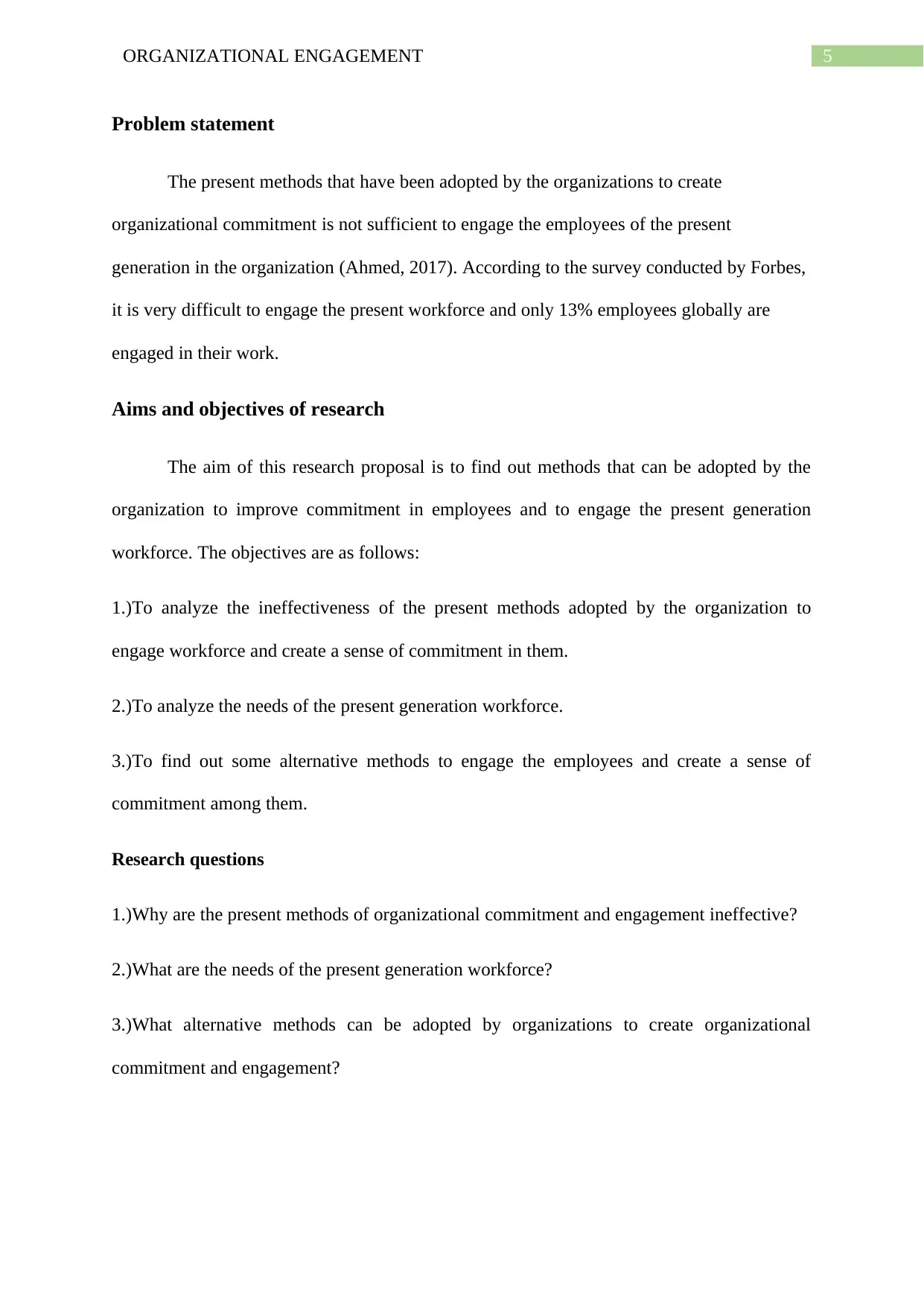
5ORGANIZATIONAL ENGAGEMENT
Problem statement
The present methods that have been adopted by the organizations to create
organizational commitment is not sufficient to engage the employees of the present
generation in the organization (Ahmed, 2017). According to the survey conducted by Forbes,
it is very difficult to engage the present workforce and only 13% employees globally are
engaged in their work.
Aims and objectives of research
The aim of this research proposal is to find out methods that can be adopted by the
organization to improve commitment in employees and to engage the present generation
workforce. The objectives are as follows:
1.)To analyze the ineffectiveness of the present methods adopted by the organization to
engage workforce and create a sense of commitment in them.
2.)To analyze the needs of the present generation workforce.
3.)To find out some alternative methods to engage the employees and create a sense of
commitment among them.
Research questions
1.)Why are the present methods of organizational commitment and engagement ineffective?
2.)What are the needs of the present generation workforce?
3.)What alternative methods can be adopted by organizations to create organizational
commitment and engagement?
Problem statement
The present methods that have been adopted by the organizations to create
organizational commitment is not sufficient to engage the employees of the present
generation in the organization (Ahmed, 2017). According to the survey conducted by Forbes,
it is very difficult to engage the present workforce and only 13% employees globally are
engaged in their work.
Aims and objectives of research
The aim of this research proposal is to find out methods that can be adopted by the
organization to improve commitment in employees and to engage the present generation
workforce. The objectives are as follows:
1.)To analyze the ineffectiveness of the present methods adopted by the organization to
engage workforce and create a sense of commitment in them.
2.)To analyze the needs of the present generation workforce.
3.)To find out some alternative methods to engage the employees and create a sense of
commitment among them.
Research questions
1.)Why are the present methods of organizational commitment and engagement ineffective?
2.)What are the needs of the present generation workforce?
3.)What alternative methods can be adopted by organizations to create organizational
commitment and engagement?
⊘ This is a preview!⊘
Do you want full access?
Subscribe today to unlock all pages.

Trusted by 1+ million students worldwide
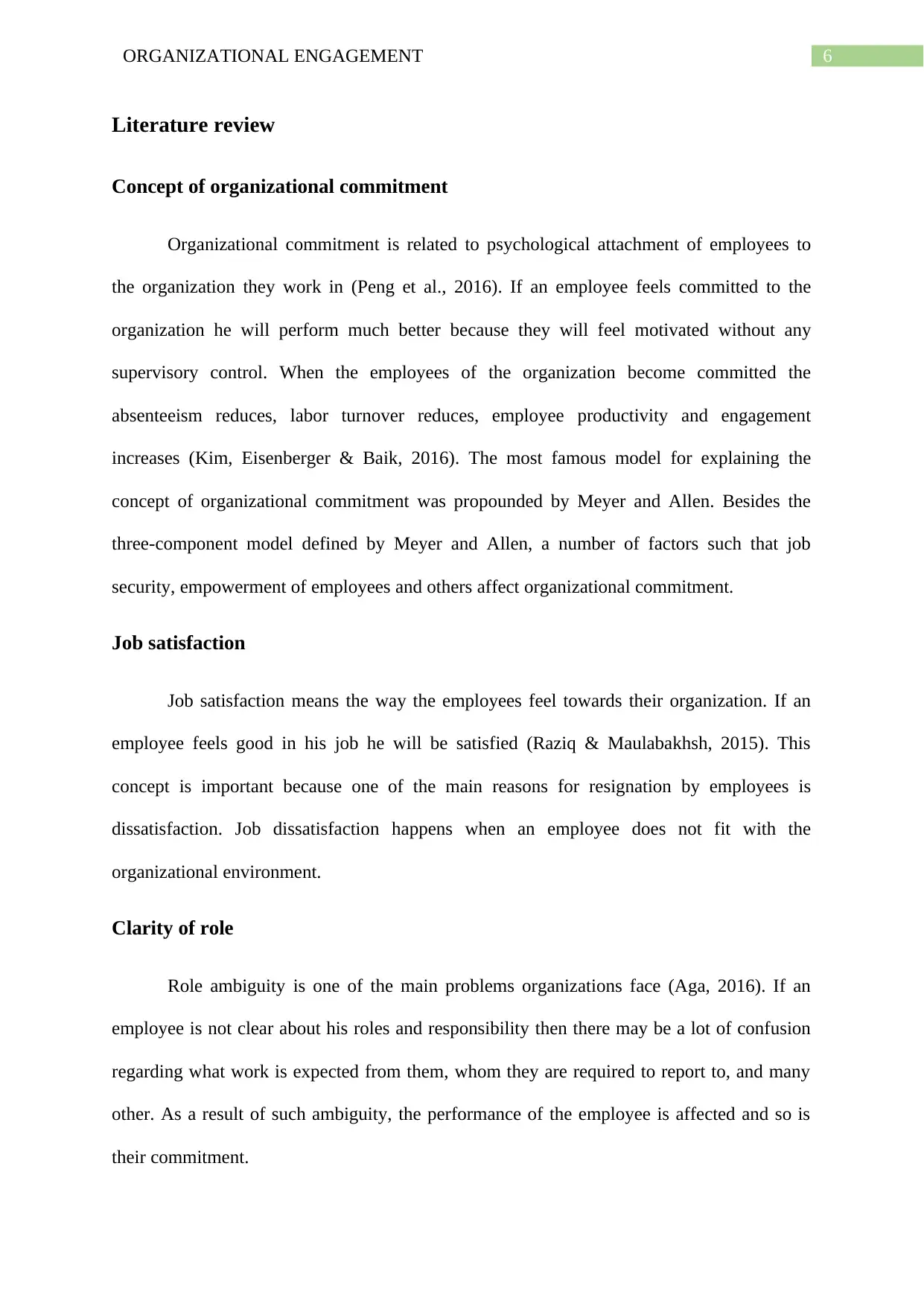
6ORGANIZATIONAL ENGAGEMENT
Literature review
Concept of organizational commitment
Organizational commitment is related to psychological attachment of employees to
the organization they work in (Peng et al., 2016). If an employee feels committed to the
organization he will perform much better because they will feel motivated without any
supervisory control. When the employees of the organization become committed the
absenteeism reduces, labor turnover reduces, employee productivity and engagement
increases (Kim, Eisenberger & Baik, 2016). The most famous model for explaining the
concept of organizational commitment was propounded by Meyer and Allen. Besides the
three-component model defined by Meyer and Allen, a number of factors such that job
security, empowerment of employees and others affect organizational commitment.
Job satisfaction
Job satisfaction means the way the employees feel towards their organization. If an
employee feels good in his job he will be satisfied (Raziq & Maulabakhsh, 2015). This
concept is important because one of the main reasons for resignation by employees is
dissatisfaction. Job dissatisfaction happens when an employee does not fit with the
organizational environment.
Clarity of role
Role ambiguity is one of the main problems organizations face (Aga, 2016). If an
employee is not clear about his roles and responsibility then there may be a lot of confusion
regarding what work is expected from them, whom they are required to report to, and many
other. As a result of such ambiguity, the performance of the employee is affected and so is
their commitment.
Literature review
Concept of organizational commitment
Organizational commitment is related to psychological attachment of employees to
the organization they work in (Peng et al., 2016). If an employee feels committed to the
organization he will perform much better because they will feel motivated without any
supervisory control. When the employees of the organization become committed the
absenteeism reduces, labor turnover reduces, employee productivity and engagement
increases (Kim, Eisenberger & Baik, 2016). The most famous model for explaining the
concept of organizational commitment was propounded by Meyer and Allen. Besides the
three-component model defined by Meyer and Allen, a number of factors such that job
security, empowerment of employees and others affect organizational commitment.
Job satisfaction
Job satisfaction means the way the employees feel towards their organization. If an
employee feels good in his job he will be satisfied (Raziq & Maulabakhsh, 2015). This
concept is important because one of the main reasons for resignation by employees is
dissatisfaction. Job dissatisfaction happens when an employee does not fit with the
organizational environment.
Clarity of role
Role ambiguity is one of the main problems organizations face (Aga, 2016). If an
employee is not clear about his roles and responsibility then there may be a lot of confusion
regarding what work is expected from them, whom they are required to report to, and many
other. As a result of such ambiguity, the performance of the employee is affected and so is
their commitment.
Paraphrase This Document
Need a fresh take? Get an instant paraphrase of this document with our AI Paraphraser
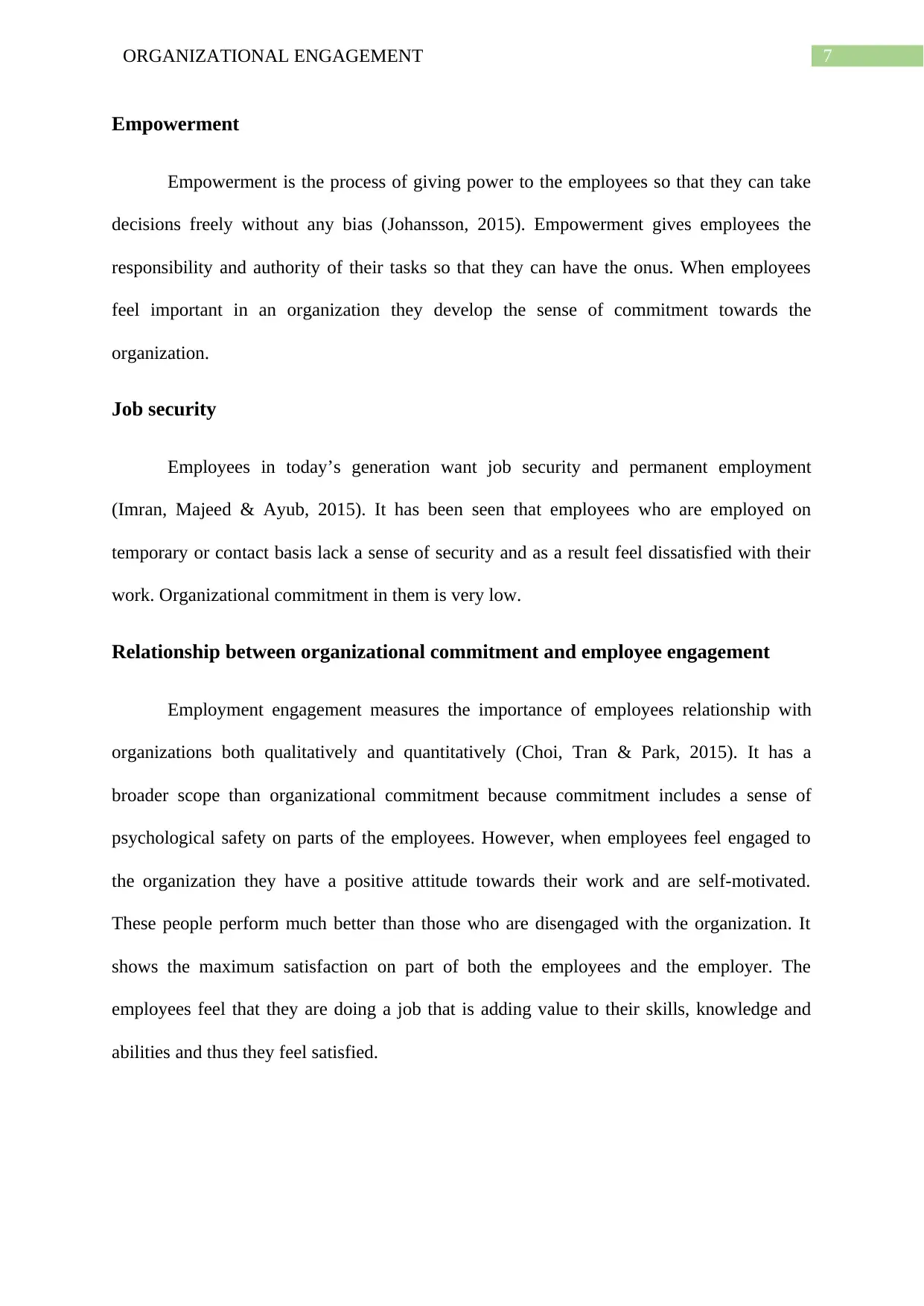
7ORGANIZATIONAL ENGAGEMENT
Empowerment
Empowerment is the process of giving power to the employees so that they can take
decisions freely without any bias (Johansson, 2015). Empowerment gives employees the
responsibility and authority of their tasks so that they can have the onus. When employees
feel important in an organization they develop the sense of commitment towards the
organization.
Job security
Employees in today’s generation want job security and permanent employment
(Imran, Majeed & Ayub, 2015). It has been seen that employees who are employed on
temporary or contact basis lack a sense of security and as a result feel dissatisfied with their
work. Organizational commitment in them is very low.
Relationship between organizational commitment and employee engagement
Employment engagement measures the importance of employees relationship with
organizations both qualitatively and quantitatively (Choi, Tran & Park, 2015). It has a
broader scope than organizational commitment because commitment includes a sense of
psychological safety on parts of the employees. However, when employees feel engaged to
the organization they have a positive attitude towards their work and are self-motivated.
These people perform much better than those who are disengaged with the organization. It
shows the maximum satisfaction on part of both the employees and the employer. The
employees feel that they are doing a job that is adding value to their skills, knowledge and
abilities and thus they feel satisfied.
Empowerment
Empowerment is the process of giving power to the employees so that they can take
decisions freely without any bias (Johansson, 2015). Empowerment gives employees the
responsibility and authority of their tasks so that they can have the onus. When employees
feel important in an organization they develop the sense of commitment towards the
organization.
Job security
Employees in today’s generation want job security and permanent employment
(Imran, Majeed & Ayub, 2015). It has been seen that employees who are employed on
temporary or contact basis lack a sense of security and as a result feel dissatisfied with their
work. Organizational commitment in them is very low.
Relationship between organizational commitment and employee engagement
Employment engagement measures the importance of employees relationship with
organizations both qualitatively and quantitatively (Choi, Tran & Park, 2015). It has a
broader scope than organizational commitment because commitment includes a sense of
psychological safety on parts of the employees. However, when employees feel engaged to
the organization they have a positive attitude towards their work and are self-motivated.
These people perform much better than those who are disengaged with the organization. It
shows the maximum satisfaction on part of both the employees and the employer. The
employees feel that they are doing a job that is adding value to their skills, knowledge and
abilities and thus they feel satisfied.
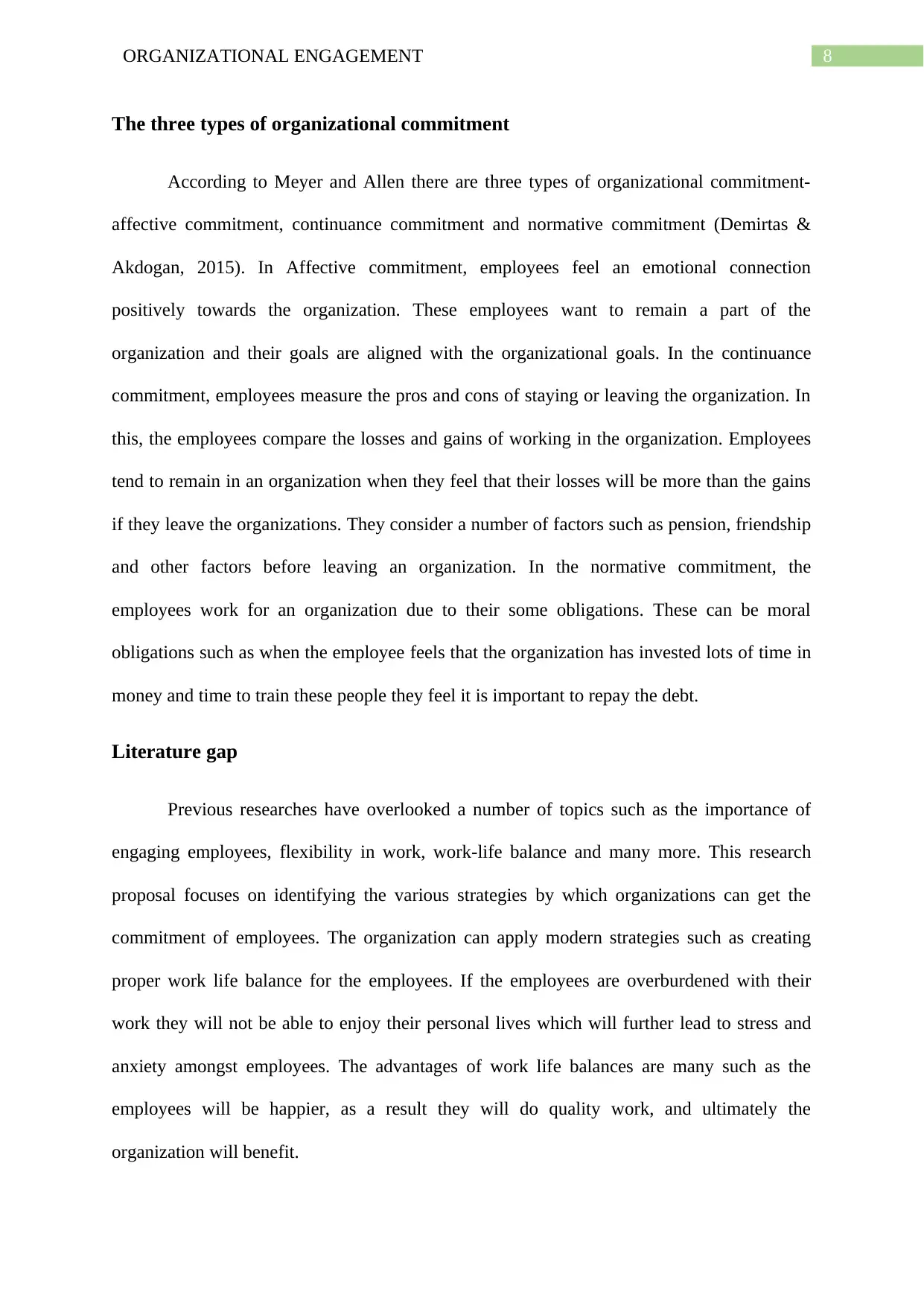
8ORGANIZATIONAL ENGAGEMENT
The three types of organizational commitment
According to Meyer and Allen there are three types of organizational commitment-
affective commitment, continuance commitment and normative commitment (Demirtas &
Akdogan, 2015). In Affective commitment, employees feel an emotional connection
positively towards the organization. These employees want to remain a part of the
organization and their goals are aligned with the organizational goals. In the continuance
commitment, employees measure the pros and cons of staying or leaving the organization. In
this, the employees compare the losses and gains of working in the organization. Employees
tend to remain in an organization when they feel that their losses will be more than the gains
if they leave the organizations. They consider a number of factors such as pension, friendship
and other factors before leaving an organization. In the normative commitment, the
employees work for an organization due to their some obligations. These can be moral
obligations such as when the employee feels that the organization has invested lots of time in
money and time to train these people they feel it is important to repay the debt.
Literature gap
Previous researches have overlooked a number of topics such as the importance of
engaging employees, flexibility in work, work-life balance and many more. This research
proposal focuses on identifying the various strategies by which organizations can get the
commitment of employees. The organization can apply modern strategies such as creating
proper work life balance for the employees. If the employees are overburdened with their
work they will not be able to enjoy their personal lives which will further lead to stress and
anxiety amongst employees. The advantages of work life balances are many such as the
employees will be happier, as a result they will do quality work, and ultimately the
organization will benefit.
The three types of organizational commitment
According to Meyer and Allen there are three types of organizational commitment-
affective commitment, continuance commitment and normative commitment (Demirtas &
Akdogan, 2015). In Affective commitment, employees feel an emotional connection
positively towards the organization. These employees want to remain a part of the
organization and their goals are aligned with the organizational goals. In the continuance
commitment, employees measure the pros and cons of staying or leaving the organization. In
this, the employees compare the losses and gains of working in the organization. Employees
tend to remain in an organization when they feel that their losses will be more than the gains
if they leave the organizations. They consider a number of factors such as pension, friendship
and other factors before leaving an organization. In the normative commitment, the
employees work for an organization due to their some obligations. These can be moral
obligations such as when the employee feels that the organization has invested lots of time in
money and time to train these people they feel it is important to repay the debt.
Literature gap
Previous researches have overlooked a number of topics such as the importance of
engaging employees, flexibility in work, work-life balance and many more. This research
proposal focuses on identifying the various strategies by which organizations can get the
commitment of employees. The organization can apply modern strategies such as creating
proper work life balance for the employees. If the employees are overburdened with their
work they will not be able to enjoy their personal lives which will further lead to stress and
anxiety amongst employees. The advantages of work life balances are many such as the
employees will be happier, as a result they will do quality work, and ultimately the
organization will benefit.
⊘ This is a preview!⊘
Do you want full access?
Subscribe today to unlock all pages.

Trusted by 1+ million students worldwide
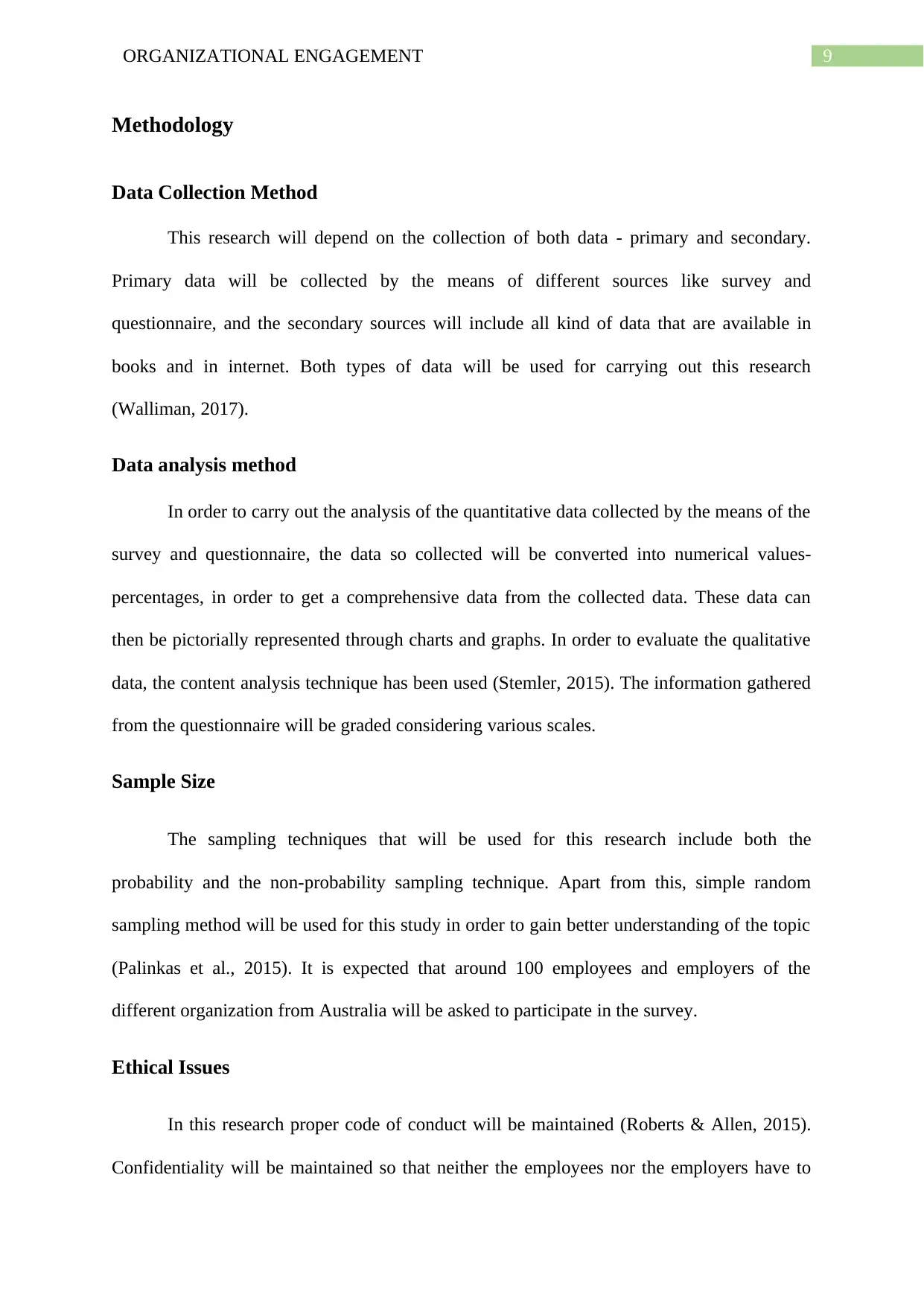
9ORGANIZATIONAL ENGAGEMENT
Methodology
Data Collection Method
This research will depend on the collection of both data - primary and secondary.
Primary data will be collected by the means of different sources like survey and
questionnaire, and the secondary sources will include all kind of data that are available in
books and in internet. Both types of data will be used for carrying out this research
(Walliman, 2017).
Data analysis method
In order to carry out the analysis of the quantitative data collected by the means of the
survey and questionnaire, the data so collected will be converted into numerical values-
percentages, in order to get a comprehensive data from the collected data. These data can
then be pictorially represented through charts and graphs. In order to evaluate the qualitative
data, the content analysis technique has been used (Stemler, 2015). The information gathered
from the questionnaire will be graded considering various scales.
Sample Size
The sampling techniques that will be used for this research include both the
probability and the non-probability sampling technique. Apart from this, simple random
sampling method will be used for this study in order to gain better understanding of the topic
(Palinkas et al., 2015). It is expected that around 100 employees and employers of the
different organization from Australia will be asked to participate in the survey.
Ethical Issues
In this research proper code of conduct will be maintained (Roberts & Allen, 2015).
Confidentiality will be maintained so that neither the employees nor the employers have to
Methodology
Data Collection Method
This research will depend on the collection of both data - primary and secondary.
Primary data will be collected by the means of different sources like survey and
questionnaire, and the secondary sources will include all kind of data that are available in
books and in internet. Both types of data will be used for carrying out this research
(Walliman, 2017).
Data analysis method
In order to carry out the analysis of the quantitative data collected by the means of the
survey and questionnaire, the data so collected will be converted into numerical values-
percentages, in order to get a comprehensive data from the collected data. These data can
then be pictorially represented through charts and graphs. In order to evaluate the qualitative
data, the content analysis technique has been used (Stemler, 2015). The information gathered
from the questionnaire will be graded considering various scales.
Sample Size
The sampling techniques that will be used for this research include both the
probability and the non-probability sampling technique. Apart from this, simple random
sampling method will be used for this study in order to gain better understanding of the topic
(Palinkas et al., 2015). It is expected that around 100 employees and employers of the
different organization from Australia will be asked to participate in the survey.
Ethical Issues
In this research proper code of conduct will be maintained (Roberts & Allen, 2015).
Confidentiality will be maintained so that neither the employees nor the employers have to
Paraphrase This Document
Need a fresh take? Get an instant paraphrase of this document with our AI Paraphraser
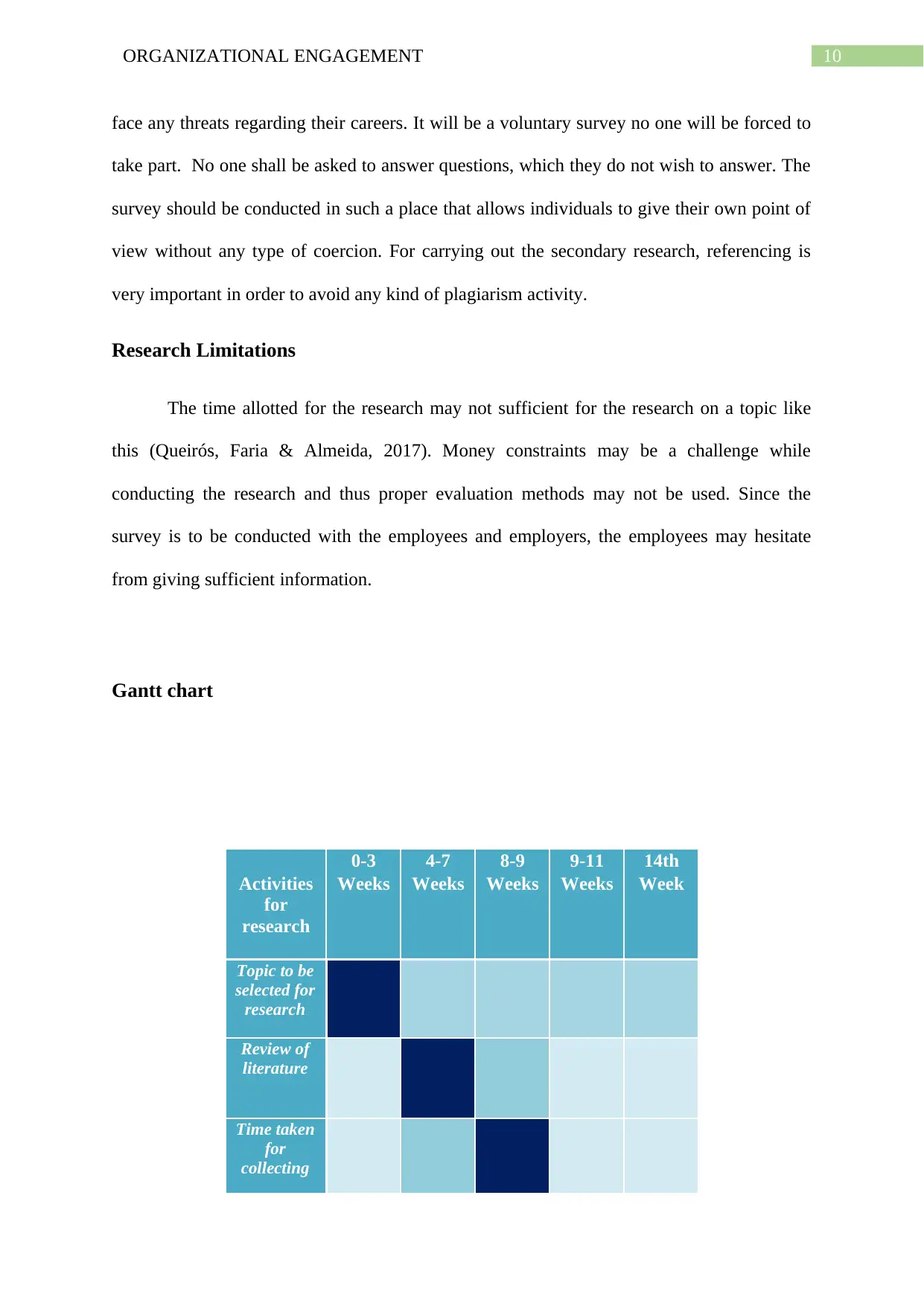
10ORGANIZATIONAL ENGAGEMENT
face any threats regarding their careers. It will be a voluntary survey no one will be forced to
take part. No one shall be asked to answer questions, which they do not wish to answer. The
survey should be conducted in such a place that allows individuals to give their own point of
view without any type of coercion. For carrying out the secondary research, referencing is
very important in order to avoid any kind of plagiarism activity.
Research Limitations
The time allotted for the research may not sufficient for the research on a topic like
this (Queirós, Faria & Almeida, 2017). Money constraints may be a challenge while
conducting the research and thus proper evaluation methods may not be used. Since the
survey is to be conducted with the employees and employers, the employees may hesitate
from giving sufficient information.
Gantt chart
0-3 4-7 8-9 9-11 14th
Activities
for
research
Weeks Weeks Weeks Weeks Week
Topic to be
selected for
research
Review of
literature
Time taken
for
collecting
face any threats regarding their careers. It will be a voluntary survey no one will be forced to
take part. No one shall be asked to answer questions, which they do not wish to answer. The
survey should be conducted in such a place that allows individuals to give their own point of
view without any type of coercion. For carrying out the secondary research, referencing is
very important in order to avoid any kind of plagiarism activity.
Research Limitations
The time allotted for the research may not sufficient for the research on a topic like
this (Queirós, Faria & Almeida, 2017). Money constraints may be a challenge while
conducting the research and thus proper evaluation methods may not be used. Since the
survey is to be conducted with the employees and employers, the employees may hesitate
from giving sufficient information.
Gantt chart
0-3 4-7 8-9 9-11 14th
Activities
for
research
Weeks Weeks Weeks Weeks Week
Topic to be
selected for
research
Review of
literature
Time taken
for
collecting
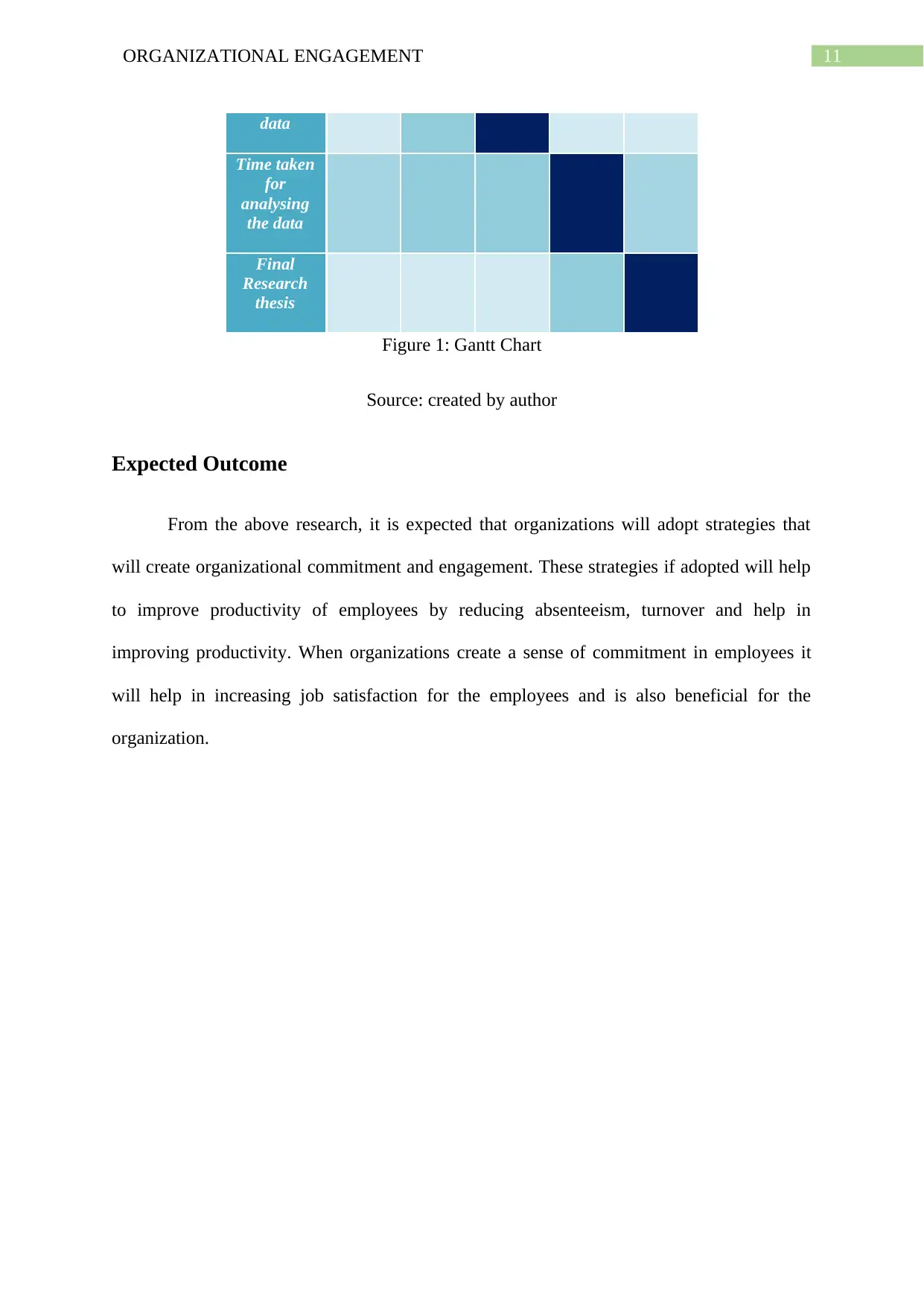
11ORGANIZATIONAL ENGAGEMENT
data
Time taken
for
analysing
the data
Final
Research
thesis
Figure 1: Gantt Chart
Source: created by author
Expected Outcome
From the above research, it is expected that organizations will adopt strategies that
will create organizational commitment and engagement. These strategies if adopted will help
to improve productivity of employees by reducing absenteeism, turnover and help in
improving productivity. When organizations create a sense of commitment in employees it
will help in increasing job satisfaction for the employees and is also beneficial for the
organization.
data
Time taken
for
analysing
the data
Final
Research
thesis
Figure 1: Gantt Chart
Source: created by author
Expected Outcome
From the above research, it is expected that organizations will adopt strategies that
will create organizational commitment and engagement. These strategies if adopted will help
to improve productivity of employees by reducing absenteeism, turnover and help in
improving productivity. When organizations create a sense of commitment in employees it
will help in increasing job satisfaction for the employees and is also beneficial for the
organization.
⊘ This is a preview!⊘
Do you want full access?
Subscribe today to unlock all pages.

Trusted by 1+ million students worldwide
1 out of 14
Related Documents
Your All-in-One AI-Powered Toolkit for Academic Success.
+13062052269
info@desklib.com
Available 24*7 on WhatsApp / Email
![[object Object]](/_next/static/media/star-bottom.7253800d.svg)
Unlock your academic potential
Copyright © 2020–2025 A2Z Services. All Rights Reserved. Developed and managed by ZUCOL.





